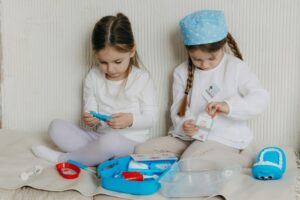Emotions are something that children learn early in life. The role of the parents is the largest in educating them on how to feel and express emotions. Emotional development activities for 3-5 year olds assist them in gaining confidence, managing social situations, and establishing good relationships.
Storytelling for Emotional Growth
Emotions are taught by stories. Read books with characters that are happy, sad, or angry. After reading, ask, “How do you think the character feels?” This will help the child identify emotions. You can also create stories about everyday life and ask your child what they would do.
Role-Playing Different Emotions
Pretend play enables children to learn about emotions. Role-play scenarios such as sharing a toy, being scared, or waiting for a turn. Make a different emotion face and then ask your child to describe the feeling. Have them role-play their own feelings as well.
Emotion Matching Games
Display images of faces with various emotions. Instruct your child to pair them with words such as happy, sad, or surprised. You may also create faces and ask, “What is the emotion?” This one little game assists them in labeling feelings.
Music and Movement for Expression
Music allows kids to communicate feelings. Play various tunes and question them about the emotions the music evokes. Get them moving according to the nature of the song. Gentle melodies induce relaxation, while quick rhythms generate enthusiasm.
Art for Emotional Expression
Children convey feelings with art. Give them crayons and have them draw their feeling. Use coloring to depict emotion—red to represent anger, blue for being sad, and yellow for joyful. Once colored, ask, “What is this picture telling you?” It allows them to communicate feelings nonverbally.
Teaching Empathy using Puppets or Toys
Use puppets or dolls to teach empathy and kindness. Role-play a scenario where one toy is sad, and the other toy hugs them. Ask your child, “What can we do to make our friend feel better?” This teaches them how to take care of others.
Deep Breathing for Emotional Control
Kids require assistance in managing intense feelings. Instruct them in deep breathing by reciting, “Smell the flower, now blow out the candle.” This is an enjoyable and easy-to-remember activity. When they become upset, remind them to breathe deeply before responding.
Encouraging Verbal Expression
Encourage children to use words to express feelings. When they are sad or angry, say, “Can you tell me what happened?” Teach them to say, “I feel.” rather than crying or hitting. Patient listening makes them feel safe to speak.
Tips for Parents
- Label emotions in everyday conversations.
- Reward your child when they use feelings in a healthy manner.
- Establish a routine to discuss feelings, such as at bedtime.
- Be a good role model by dealing with your own feelings in a calm manner.
- Model and promote play with peers to develop social skills.
Indian Parent FAQs about Emotional Development Activities for 3-5 year olds
- How do I assist my child to talk about emotions rather than act them out?
Get them to talk by asking them, “How do you feel?” and teach them how to put words on feelings.
- My child frustrates easily. What do I do?
Instructing deep breathing and basic calming strategies such as counting to five or cuddling a stuffed animal.
- What are the basic emotional development activities?
Storytelling, role play, drawing, and music activities assist children in communicating and understanding emotions.
- How do I get my child to be nice to others?
Model kind behavior at home, compliment kind behaviors, and promote sharing and assisting others.
- How long should I do emotional development activities?
A few minutes a day is sufficient. Use daily situations to discuss feelings and solutions.
Conclusion
Emotional teaching is a vital aspect of parenting. Simple activities assist children in recognizing, expressing, and regulating feelings. Parents who facilitate emotional development bring up confident, kind, and happy children.




